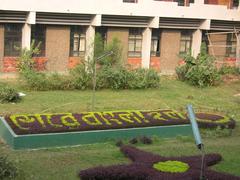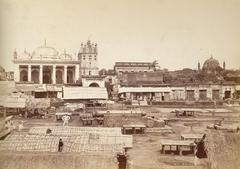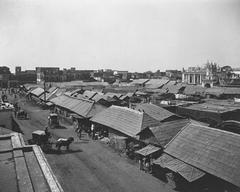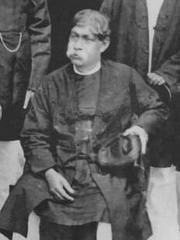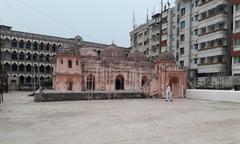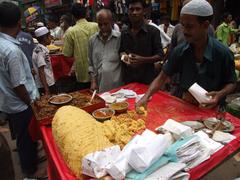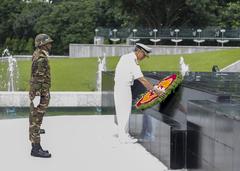Hajiganj Fort Visiting Guide: Hours, Tickets, and Nearby Historical Sites in Dhaka
Date: 24/07/2024
Discover the Rich History and Cultural Significance of Hajiganj Fort
Hajiganj Fort, also known as Khizirpur Fort, stands as a monumental testament to the rich historical and architectural heritage of Narayanganj, Bangladesh. Constructed around 1610 CE during the Mughal era, the fort played a pivotal role in the defense strategy of the Mughal Empire, aimed at protecting Dhaka from external threats, including pirates and local insurgents. Situated on the western bank of the Shitalakshya River, the fort’s strategic location was crucial for monitoring and controlling riverine traffic, thereby preventing unauthorized access to the capital (UNESCO).
The fort’s robust architectural features, including its rectangular structure, circular sections, fortified walls, and bastions, highlight its primary use as a defensive stronghold. The elevated platforms for cannons, musketry holes, and observation towers within the fort complex further underscore its strategic military importance. The fort was part of a larger network of forts, including Sonakanda and Idrakpur Forts, which collectively formed a comprehensive defense system around Dhaka (The Daily Star).
Today, Hajiganj Fort is a well-preserved remnant of Mughal Dhaka, thanks to the diligent restoration efforts by the Department of Archaeology. The fort not only offers a fascinating glimpse into the past but also serves as a popular tourist destination, attracting history enthusiasts and travelers from around the world. This comprehensive guide aims to provide you with all the essential information you need to plan your visit to Hajiganj Fort, including visiting hours, ticket prices, travel tips, and nearby attractions.
Explore the Contents of This Comprehensive Guide
- Introduction
- Historical Background and Architectural Features
- Historical Background
- Architectural Features
- Structure and Layout
- Bastions and Merlons
- Rampart Walkway
- Observation Tower
- Restoration and Maintenance
- Strategic Importance
- Visitor Information
- Location and Accessibility
- Visiting Hours and Tickets
- Visitor Tips
- Nearby Attractions
- FAQ
- Conclusion
Introduction
Hajiganj Fort, also known as Khizirpur Fort, is a historical gem located in Narayanganj, Bangladesh. Constructed around 1610 CE during the Mughal era, this fort offers a fascinating glimpse into the past. This article provides detailed information on visiting hours, ticket prices, and other essential details to make your visit memorable.
Historical Background and Architectural Features
Historical Background
Hajiganj Fort, also known as Khizirpur Fort, is a significant historical site located in Narayanganj, Bangladesh. The fort’s construction dates back to around 1610 CE, during the Mughal era. According to the 17th-century chronicle Bahrishtan-i-Ghaybi by Mirza Nathan, a Mughal general in Bengal, the fort was extensively used by Mughal subahdar Islam Khan as a military base for operations against the Bara Bhuiyans, an alliance of local landlords (UNESCO).
The fort was part of a strategic defense mechanism established by the Mughals to protect the capital, Dhaka, from external threats such as the Magh/Arakanese, Portuguese, and Dutch pirates. This defense system included other forts like Sonakanda Fort and Idrakpur Fort, forming a “Triangle of Waterforts” around Dhaka (The Daily Star).
Architectural Features
Structure and Layout
Hajiganj Fort is a rectangular structure with a unique circular section on the west side, where an elevated platform was used for long-range heavy cannon bombardment. The fort’s design includes several spaces for placing cannons at different sides, indicating its primary use as a defensive stronghold (The Daily Star).
The fort is entirely constructed with brick and covered with plaster. The fortification wall and bastions are crowned by numerous big merlons perforated with varying loopholes for muskets. These loopholes are not uniform in size or number, suggesting they were used for operational purposes rather than decorative reasons (UNESCO).
Bastions and Merlons
The fort features rounded corner bastions, which were used to place cannons. The three bastions facing the river Shitalakkha are larger in diameter, while the other three are smaller. This design allowed for a strategic defense against riverine attacks. The bastions and merlons are equipped with musketry holes, providing a fortified line of defense against invaders (Lonely Traveler).
Rampart Walkway
On the inner side of the curtain wall, there is a 1.22-meter-high rampart walkway from the base of the curtain wall, which is itself pierced by several musketry holes. These holes were likely intended for firing guns at pirates proceeding up the river. The walkway allowed soldiers to move along the fort’s perimeter while remaining protected from enemy fire (Wikipedia).
Observation Tower
Within the fort enclosure, there is a tall, free-standing square brick column, which likely served as an observation point and a platform for placing guns during the rainy season. This tower provided a vantage point for monitoring enemy movements and coordinating defensive actions (Amader Narayanganj).
Restoration and Maintenance
The fort was in ruins before the Department of Archaeology took up the work of restoration and maintenance. Today, it is a well-maintained remnant of Mughal Dhaka, offering visitors a glimpse into the region’s rich historical past. The restoration efforts have preserved the fort’s structural integrity while making it accessible to the public (The Daily Star).
Strategic Importance
Hajiganj Fort played a crucial role in the Mughal military strategy. It was frequently used by Islam Khan to command military operations against the Bhuyians. The fort, along with Sonakanda and Idrakpur forts, served as a defense center to protect Dhaka from external enemies. Subahdar Mir Jumla extensively used these forts for military expeditions, highlighting their strategic importance in the region (UNESCO).
Visitor Information
Location and Accessibility
The fort is situated on the western bank of the river Shitalakkha, approximately 15 kilometers from Dhaka city. It is located at the outskirts of Narayanganj city, near the Narayanganj-Demra Road. The fort was originally built on a riverbank, but the channel has shifted its course towards the east over time (The Daily Star).
Visiting Hours and Tickets
Hajiganj Fort is open to visitors from 9:00 AM to 6:00 PM every day. The ticket prices are very affordable, with adults charged 20 BDT and children 10 BDT. There are no special events or guided tours currently available, but the fort’s historical significance makes it a worthwhile visit.
Visitor Tips
For those planning to visit Hajiganj Fort, it is advisable to avoid visiting during the evening or night, as the area can be unsafe due to the presence of drug addicts. The best time to visit is during the day when the fort is well-lit and maintained. Visitors can reach the fort by taking a bus or train to Narayanganj and then a rickshaw to the fort’s location. The GPS coordinates for the fort are 23°38’1.17″N, 90°30’46.53″E (Lonely Traveler).
Nearby Attractions
While in Narayanganj, visitors can explore other historical sites such as Sonakanda Fort and Idrakpur Fort. The city also offers a rich cultural experience with its bustling markets and local cuisine.
FAQ
- What are the visiting hours for Hajiganj Fort? The fort is open from 9:00 AM to 6:00 PM every day.
- How much are the tickets for Hajiganj Fort? Ticket prices are 20 BDT for adults and 10 BDT for children.
- Is there a guided tour available? Currently, there are no guided tours available.
- What are the nearby attractions? Nearby attractions include Sonakanda Fort, Idrakpur Fort, and local markets in Narayanganj.
Conclusion
Hajiganj Fort stands as a testament to the rich historical and architectural heritage of Bangladesh. Its strategic importance, unique architectural features, and well-preserved condition make it a must-visit site for history enthusiasts and tourists alike. The fort’s restoration and maintenance efforts have ensured that it remains a significant landmark, offering insights into the Mughal era’s military strategies and architectural prowess. For more historical sites and updates, follow us on social media and check out our other articles.





